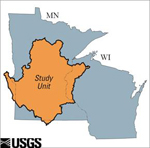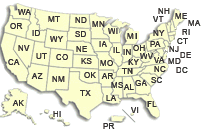Minnesota Water Science Center

UMIS NAWQAUSGS IN YOUR STATEUSGS Water Science Centers are located in each state. 
|
Few Volatile Organic Compounds Detected in Rivers and Ground Water in the Upper Mississippi River Basin, Minnesota and Wisconsin: U.S. Geological Survey Fact Sheet FS-095-96By Andrews, W.J. Abstract
Volatile organic compounds (VOC's) were detected in less than five percent of water samples from rivers and wells collected and analyzed by Federal and state agencies in the Upper Mississippi River Basin from 1978-94. The most frequently detected VOC's were commonly used solvents and gasoline components. What are Volatile Organic Compounds (VOC's)? VOC's are carbon-containing chemicals that readily evaporate at normal air temperature and pressure. They are contained in many commercial products such as gasoline, paints, adhesives, solvents, wood preservatives, dry-cleaning agents, pesticides, cosmetics, correction fluid, and refrigerants. Approximately 15 million pounds of VOC's were released to the atmosphere in the study area (FIGURE 1) in 1992 by facilities registered with the U.S. Environmental Protection Agency. Millions of additional pounds of VOC's are emitted to the atmosphere and to land and water by smaller unregistered users of these compounds in the study area. Concerns about VOC's Exposure to VOC's in the air we breathe and the water we drink is a human-health issue. Some VOC's are suspected carcinogens (benzene, trichloroethene, tetrachloroethene, and 1,1-dichloroethene). In high concentrations, many VOC's can also be toxic to humans or wildlife. Sources of Data As part of the U.S. Geological Survey's National Water-Quality Assessment (NAWQA) Program, water-quality data from rivers and wells sampled from 1978 to 1994 were summarized to provide a general assessment of water quality in the study area. Data from rivers were from Federal and State agencies, which used similar collection and analytical methods. Ground-water-quality data were collected by Federal and state agencies from domestic and public water-supply wells. Few VOC's are detectable in Rivers Because of their volatility, VOC's are not likely to be detected in rivers, except immediately downstream from points of VOC discharges. Most river samples (FIGURE 2) did not contain VOC's. VOC's that were detected in a few water samples from the Mississippi River included: trichloroethene, benzene, toluene; 1,2-dichoroethane, ethylbenzene, xylenes; 1,1,1-trichloroethane, ethylbenzene, chloroethene, and acrylonitrile. VOC's are more Frequently Detected in Well Water VOC's are more likely to be detected in ground water than in rivers. Volatilization of VOC's from ground water is not rapid because most ground water is not in direct contact with the atmosphere. VOC's can be absorbed by clays or organic materials, or can be broken down by bacteria and other microbes in soils or in underlying aquifers. The highest concentrations of VOC's in ground water are usually near sites of spills or leaks of these compounds. Several reports released by the Minnesota Department of Health indicated increased frequencies of detection of VOC's in water from domestic and public supply wells within a mile of VOC sources such as landfills. National Water Quality Assessment Program The Upper Mississippi River Basin is 1 of 15 on-going study units started in 1994 as part of the U.S. Geological Survey's NAWQA Program. The purpose of the program is to assess the quality of a large, representative part of the nation's water resources. Retrospective analyses of water-quality data summarized in this fact sheet and in Andrews and others (1995) is the first stage of activity for each study unit. In subsequent years, samples from widespread networks of surface-water sites, ecological sites, and wells will be analyzed for hundreds of constituents to evaluate the quality of water resources in the basin and the effects of natural and human factors on water quality. Suggestions for Further Reading Andrews, W.J., Fallon, J.D., and Korening, S.E., 1995, Water quality assessment of part of the Upper Mississippi River Basin, Minnesota and Wisconsin--Volatile organic compounds in surface and ground water: U.S. Geological Survey Water-Resources Investigations Report 95-4216, 39 p. Minnesota Department of Health, 1989, Water supply monitoring near metropolitan solid waste disposal facilities, Report to the Legislative Commission on Minnesota Resources: Minnesota Department of Health, Section of Water Supply and Engineering, Minneapolis, 34 p. Stark, J.R., 1994, National Water-Quality Assessment Program--the Upper Mississippi River Basin: U.S. Geological Survey Open-File Report 94-101, 2p. U.S. Environmental Protection Agency, 1994, 1992 Toxic Release Inventory, Public Data Release: U.S. Environmental Protection Agency, EPA745-R-94-101, 372 p. Copies of this report and information on all USGS products can be obtained by calling 1-888-ASK-USGS |